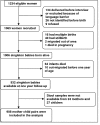Prevalence and risk factors for soil-transmitted helminth infection in mothers and their infants in Butajira, Ethiopia: a population based study
- PMID: 20085635
- PMCID: PMC2835680
- DOI: 10.1186/1471-2458-10-21
Prevalence and risk factors for soil-transmitted helminth infection in mothers and their infants in Butajira, Ethiopia: a population based study
Abstract
Background: Soil-transmitted helminths (STHs) are widespread in underdeveloped countries. In Ethiopia, the prevalence and distribution of helminth infection varies by place and with age. We therefore investigated the prevalence of and risk factors for STH infection in mothers and their one year-old children living in Butajira town and surrounding rural areas in southern Ethiopia.
Methods: In 2005-2006, 1065 pregnant women were recruited in their third trimester of pregnancy. In 2006-2007, when children reached their first birthdays, data on the infants and their mothers were collected, including stool samples for qualitative STH analysis. Questionnaire data on various demographic, housing and lifestyle variables were available. Logistic regression analysis was employed to determine the independent risk factors for STH infection in the mothers and children.
Results: 908 mothers and 905 infants provided complete data for analysis. Prevalence of any STH infection was 43.5% (95% confidence interval (CI) 40.2-46.8%) in mothers and 4.9% (95%CI 3.6-6.5%) in children. In the fully adjusted regression model, infrequent use of soap by the mother was associated with increased risk (odds ratio (OR) 1.40, 95% CI 1.04-1.88, and 1.66, 95% CI 0.92-2.99, for use at least once a week and less frequent than once a week respectively, relative to daily use; p for trend = 0.018), and urban place of residence (OR 0.45, 95% CI 0.28-0.73, p = 0.001) was associated with reduced risk of maternal STH infection. The only factor associated with STH infection in infants was household source of water, with the greatest risk in those using piped water inside the compound (OR 0.09, 95% CI 0.02-0.38 for river water, 0.20, 95% CI 0.56-0.69 for either well or stream water and 0.21, 95% CI 0.09-0.51 for piped water outside compared with piped water inside the compound, overall p = 0.002)
Conclusion: In this rural Ethiopian community with a relatively high prevalence of STH infection, we found a reduced risk of infection in relation to maternal hygiene and urban living. Daily use of soap and a safe supply of water are likely to reduce the risk of STH infection.
Similar articles
-
Soil-Transmitted Helminths and Associated Factors among Pre-School Children in Butajira Town, South-Central Ethiopia: A Community-Based Cross-Sectional Study.PLoS One. 2015 Aug 25;10(8):e0136342. doi: 10.1371/journal.pone.0136342. eCollection 2015. PLoS One. 2015. PMID: 26305361 Free PMC article.
-
Soil-transmitted helminths and associated factors among pregnant women in Doreni district, Oromia region, Ethiopia: a cross-sectional study.BMC Infect Dis. 2024 Apr 24;24(1):435. doi: 10.1186/s12879-024-09331-y. BMC Infect Dis. 2024. PMID: 38658830 Free PMC article.
-
Soil transmitted Helminthiasis and associated risk factors among elementary school children in ambo town, western Ethiopia.BMC Public Health. 2017 Oct 10;17(1):791. doi: 10.1186/s12889-017-4809-3. BMC Public Health. 2017. PMID: 29017470 Free PMC article.
-
Prevalence soil transmitted helminthiasis and malaria co-infection among pregnant women and risk factors in Gilgel Gibe Dam area, southwest Ethiopia.BMC Res Notes. 2013 Jul 9;6:263. doi: 10.1186/1756-0500-6-263. BMC Res Notes. 2013. PMID: 23837685 Free PMC article.
-
Prevalence of Soil-Transmitted Helminth Infection Among School-Aged Children of Ethiopia: A Systematic Review and Meta-Analysis.Infect Dis (Auckl). 2020 Oct 5;13:1178633720962812. doi: 10.1177/1178633720962812. eCollection 2020. Infect Dis (Auckl). 2020. PMID: 33088182 Free PMC article. Review.
Cited by
-
School-Based Intervention: Evaluating the role of Water, Latrines and Hygiene Education on Trachoma and Intestinal Parasitic Infections in Ethiopia.J Water Sanit Hyg Dev. 2014;4(1):120-130. doi: 10.2166/washdev.2013.060. J Water Sanit Hyg Dev. 2014. PMID: 25859318 Free PMC article.
-
The epidemiology of soil-transmitted helminths in Bihar State, India.PLoS Negl Trop Dis. 2015 May 20;9(5):e0003790. doi: 10.1371/journal.pntd.0003790. eCollection 2015 May. PLoS Negl Trop Dis. 2015. PMID: 25993697 Free PMC article.
-
Prevalence and risk factors of intestinal protozoan infections: a population-based study in rural areas of Boyer-Ahmad district, Southwestern Iran.BMC Infect Dis. 2016 Nov 25;16(1):703. doi: 10.1186/s12879-016-2047-4. BMC Infect Dis. 2016. PMID: 27884121 Free PMC article.
-
The role of co-infections in mother-to-child transmission of HIV.Curr HIV Res. 2013 Jan;11(1):10-23. doi: 10.2174/1570162x11311010003. Curr HIV Res. 2013. PMID: 23305198 Free PMC article. Review.
-
Needs, acceptability, and value of humanitarian medical assistance in remote Peruvian Amazon riverine communities.Am J Trop Med Hyg. 2015 Jun;92(6):1090-9. doi: 10.4269/ajtmh.14-0329. Epub 2015 Apr 6. Am J Trop Med Hyg. 2015. PMID: 25846293 Free PMC article.
References
-
- Hotez JP, de Silva N, Brooker S, Bethony J. Working paper No.3, Disease Control Priorities Project. Bethesda, Maryland: Fogarty International Center, National Institute of Health; 2003. Soil-Transmitted Infections: The Nature, Causes and Burden of the Condition.http://www.dcp2.org/file/19/wp3.pdf
-
- Federal Ministry of Health. Guidelines for the Enhanced Outreach Strategy (EOS) for Child Survival Interventions. Addis Ababa, Ethiopia; 2004.
Publication types
MeSH terms
Substances
Grants and funding
LinkOut - more resources
Full Text Sources


